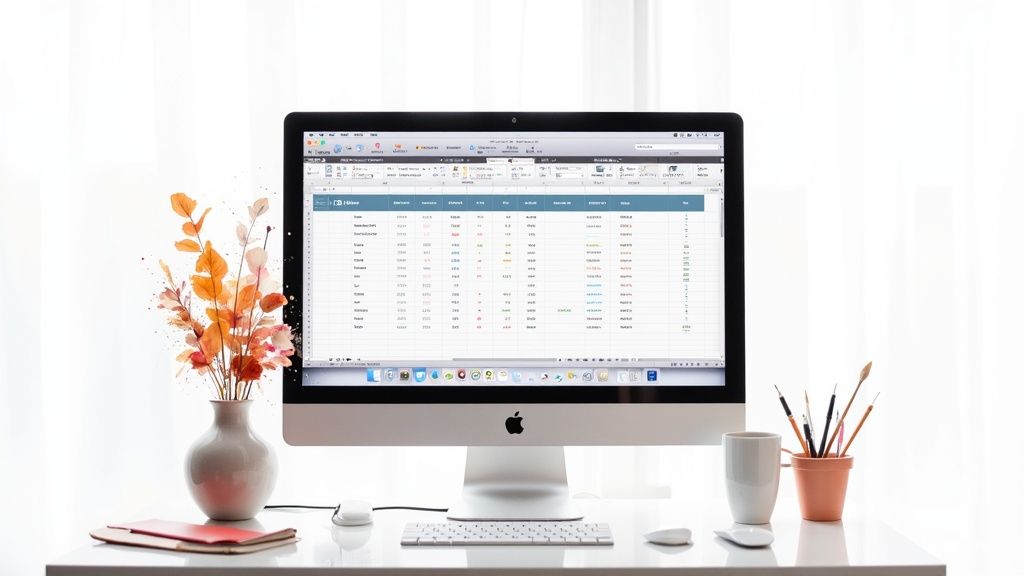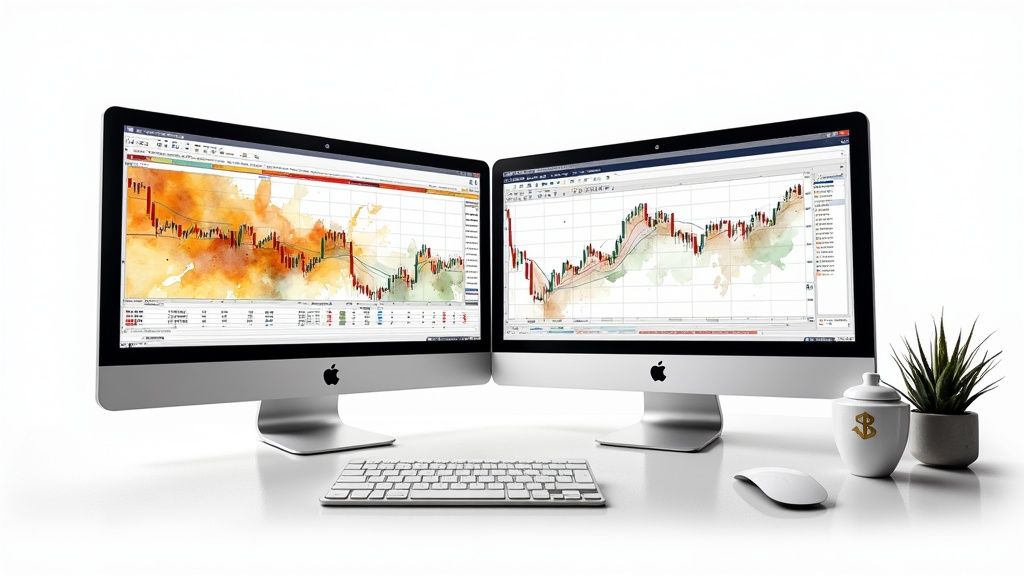




While many cryptocurrency tracking apps promise ease of use, experienced investors often prefer the robust functionality and adaptability of spreadsheets. This preference isn't about outdated habits. It reflects the significant control a spreadsheet offers for managing cryptocurrency investments. Professional traders, for instance, need tools that can keep pace with their evolving strategies, a need spreadsheets fulfill effectively.
A key reason seasoned investors choose spreadsheets is their adaptability. Unlike apps with fixed features, spreadsheets allow for complete customization. Investors can add, remove, or modify columns to precisely track relevant metrics, tailored to their investment approach. They can even create custom formulas for calculations not found in standard tracking apps. This personalized approach allows for in-depth portfolio analysis, aligned with individual investor goals.
Managing cryptocurrency investments across various exchanges presents logistical hurdles. Spreadsheets provide a central platform to consolidate all holdings into a single view. This streamlined overview simplifies portfolio performance monitoring and informs better investment decisions. Moreover, spreadsheets address critical privacy concerns. Investors retain full control over their sensitive financial data, avoiding the risks associated with sharing transaction details with third-party platforms. For further insights into crypto privacy, see: Decoding the Crypto Anonymity Paradox.
Many crypto tracking apps charge subscription fees that impact investment returns. Spreadsheets, conversely, are often free (like Google Sheets), eliminating recurring costs. This allows investors to allocate more capital towards their investments. Furthermore, spreadsheets grant users complete data ownership. Information resides on the user's device or chosen cloud storage, minimizing dependence on external services and ensuring constant access and control.
Using Google Sheets for cryptocurrency tracking is gaining popularity. A simple spreadsheet can track cryptocurrency names, amounts held, purchase prices, current prices, and total values, enabling efficient portfolio monitoring. The IMPORTXML() function can even fetch live price data for real-time updates. While this requires some initial setup, it provides a powerful, free tool for managing digital assets. Learn more: Tracking Cryptocurrency with Google Sheets.
The primary advantage of using a spreadsheet is its impact on decision-making. By providing a clear, customizable, and comprehensive view of crypto holdings, spreadsheets empower investors to make informed decisions based on accurate, personalized data. This applies to day traders, long-term holders, and everyone in between. A well-structured spreadsheet can be an invaluable asset throughout the crypto investment journey.

A well-structured spreadsheet for cryptocurrency isn't just a static record of transactions. It's a dynamic tool—a command center—for actively managing your investments. This section analyzes the vital components that transform raw data into actionable insights, allowing you to make informed decisions as your portfolio evolves. Building this structure correctly from the outset is key for long-term success.
Every effective cryptocurrency spreadsheet begins with accurate and comprehensive transaction data. This goes beyond simply recording the coin and quantity. The precise acquisition timestamp is crucial for tax purposes and performance analysis. Equally important is meticulously tracking your cost basis. This includes the original purchase price of each asset plus any associated fees, forming the foundation for calculating profits and losses, and informing your buy/sell/hold decisions.
Historical data offers valuable context, but real-time information fuels effective portfolio management. Your spreadsheet should reflect current market conditions. Integrating live price feeds provides real-time valuation of your holdings, enabling you to respond effectively to market fluctuations. Visualizing your portfolio allocation – the percentage held in each cryptocurrency – reveals potential overexposure and empowers strategic diversification for more robust risk management.
Whether you're a day trader executing numerous transactions or a long-term holder focused on a select few assets, your spreadsheet should be tailored to your specific strategy. For frequent traders, detailed trade logs with precise entry and exit points, along with individual profit/loss figures, are critical. Long-term holders, however, might prioritize metrics like annualized returns and overall portfolio growth. A spreadsheet’s adaptability allows for this vital customization.
The true power of a cryptocurrency spreadsheet lies in its capacity for automation. Simple formulas can calculate your total portfolio value, realized and unrealized gains, and the performance of individual assets. More advanced calculations, such as time-weighted return, offer a more nuanced performance measure over time, regardless of deposits or withdrawals. These automated calculations not only save time but also minimize the risk of manual errors, allowing you to focus on strategy.
To illustrate the essential data points for tracking your crypto investments effectively, let's examine the following table:
Essential Columns for Your Crypto Spreadsheet: A comprehensive breakdown of must-have spreadsheet columns for effective cryptocurrency tracking
| Column Name | Purpose | Formula Example (Simplified) | Why It's Important |
|---|---|---|---|
| Date Acquired | Records the purchase date. | - | Essential for tax reporting and performance analysis. |
| Cryptocurrency | Identifies the specific asset. | - | Enables tracking individual asset performance. |
| Quantity | Amount of cryptocurrency purchased. | - | Used for valuation and portfolio allocation. |
| Purchase Price | Price per unit at the time of purchase. | - | Basis for calculating profit/loss. |
| Fees | Transaction fees incurred. | - | Affects true cost basis and overall returns. |
| Cost Basis | Total cost including fees. | Quantity * Purchase Price + Fees |
Foundation for accurate profit/loss calculations. |
| Current Price | Real-time price of the asset. | (Live data integration) | Provides current portfolio valuation. |
| Current Value | Current value of your holdings. | Quantity * Current Price |
Shows real-time worth of your investment. |
| Gain/Loss | Profit or loss on the investment. | Current Value - Cost Basis |
Tracks overall investment performance. |
| Portfolio % | Percentage of portfolio allocated to asset. | Current Value / Total Portfolio Value |
Highlights asset diversification. |
The table above highlights the key data points required for comprehensive portfolio tracking. By incorporating these columns and their respective formulas, you can gain a granular understanding of your crypto holdings and their performance.
By implementing these essential components, your spreadsheet transforms from a basic record-keeping tool into a dynamic platform for strategic crypto investment management. This establishes a solid foundation for incorporating live market data and more advanced analytics, which will be explored further in subsequent sections.

Manually updating cryptocurrency prices in a spreadsheet is a tedious process, rife with potential errors. Savvy crypto investors recognize the value of automation. They transform static spreadsheets into dynamic dashboards, leveraging real-time market data for up-to-the-minute portfolio insights. This section explores how to achieve this same level of efficiency.
Google Sheets offers powerful built-in functions for retrieving live data, making it a strong platform for a live cryptocurrency spreadsheet. The IMPORTXML function extracts specific data points from websites, while IMPORTHTML imports entire tables or lists. For real-time price data from major exchanges, the GOOGLEFINANCE function provides a simple, yet effective solution.
To fetch the current Bitcoin price in USD, for example, use the formula: =GOOGLEFINANCE("CURRENCY:BTCUSD"). This dynamically updates your sheet with the latest price, eliminating manual input. Similarly, IMPORTXML can pull specific data points from cryptocurrency data websites for more granular tracking.
Excel users can achieve live crypto integration through Power Query. This powerful tool connects to diverse data sources, including web APIs and databases. For a more user-friendly approach, numerous add-ins offer pre-built integrations with cryptocurrency exchanges and data providers.
This accessibility to dynamic updates, regardless of your preferred spreadsheet software, eliminates tedious manual entry and allows for real-time portfolio tracking. Specialized tools can further enhance your spreadsheet's functionality for a more comprehensive data experience.
The reliability of your data source is paramount when integrating live data. While some free APIs offer basic price information, they may lack the robustness and consistency of premium data providers. Understanding the trade-offs between free and paid sources is crucial. A sudden API outage can disrupt your spreadsheet and lead to inaccuracies.
Developing backup strategies is essential to mitigate potential data disruptions. A secondary data source or a manual update process as a fallback ensures accurate portfolio valuation, even during downtime. This proactive approach to data management ensures data integrity and allows for consistent tracking. Cryptosheets is a powerful add-in for both Excel and Google Sheets, providing unified access to real-time and historical cryptocurrency data from hundreds of providers. With over 5,000 data products and integrations with major exchanges like Coinbase and FTX, Cryptosheets simplifies cryptocurrency market tracking. It allows users to create dynamic dashboards without programming skills, making it accessible to everyone from hobbyists to institutional investors. Explore this topic further: Discover more insights about Cryptosheets.
Integrating live data can present technical hurdles. Common issues include incorrect formula syntax, API limitations, or data formatting inconsistencies. Online resources and community forums can be invaluable in these situations. Troubleshooting guides and active communities offer solutions to common problems, helping you optimize your spreadsheet for seamless data flow. This frees you to focus on data analysis, not technical troubleshooting. By implementing these strategies, you can create a dynamic and reliable cryptocurrency spreadsheet as a powerful investment management tool.

A simple spreadsheet can become a powerful tool for cryptocurrency analysis. Going beyond basic profit and loss calculations offers deeper insights into your portfolio's performance and the market forces at play. This data-driven approach empowers you to adapt your investment strategy as needed.
Simple return calculations can be misleading, especially when deposits and withdrawals vary. Time-weighted return (TWR) provides a more accurate view. TWR isolates investment performance from the timing of cash flows, giving a clearer reflection of your strategy's effectiveness. This is particularly useful for comparing performance across different time periods. You can calculate TWR in your spreadsheet with built-in functions and custom formulas tailored to your investment activity.
Understanding the volatility of your crypto assets is crucial for risk management. Spreadsheets allow you to calculate volatility using historical price data. This data empowers you to make informed decisions about portfolio diversification.
Analyzing the correlation between different cryptocurrencies in your portfolio is also essential. This helps identify potential overexposure to specific market trends. For example, if several holdings move in the same direction, a downturn in one could significantly impact your overall portfolio. Identifying assets with low or negative correlations allows for more effective diversification and a more resilient portfolio.
Statistical analysis is key to understanding cryptocurrency market trends and making informed investment decisions. By applying statistical methods to historical data, investors can identify patterns and potentially predict future market movements. Analyzing percentage price changes in cryptocurrencies, for example, reveals insights into volatility and risk. Spreadsheets offer a platform to organize and visualize this data. You can find more information about percentage change analysis here: Learn more about percentage change analysis.
Spreadsheets can act as your proactive investment assistant. Using conditional formatting and built-in notification features, you can set automated alerts. These alerts can notify you of significant price movements, when predetermined profit/loss thresholds are reached, or when rebalancing opportunities arise. This allows for timely adjustments to your strategy, helping you capitalize on market shifts or mitigate potential losses.
These advanced analytical capabilities transform a basic spreadsheet into an active investment management tool. Understanding time-weighted returns, assessing volatility and correlation, and implementing automated alerts provide a significant advantage in the cryptocurrency market. This strategic approach allows for more informed decisions, proactive responses to market changes, and portfolio optimization for long-term success.
Cryptocurrency spreadsheets are more than just static grids of data; they are dynamic tools for visualizing and understanding your financial performance. Savvy crypto investors recognize that simply seeing numbers isn't enough. They utilize visualization techniques to uncover hidden patterns and gain valuable insights. Let's explore how you can do the same.
Effective charts can transform complex cryptocurrency data into clear, actionable strategies. For example, a pie chart can instantly reveal portfolio concentrations and potential risks. A pie chart dominated by one asset immediately highlights over-reliance and the need for diversification. This visual representation underscores the importance of spreading your investments in the often-volatile crypto market.
Heat maps offer another powerful tool for visualization. They can uncover hidden correlations between different assets. Perhaps two seemingly unrelated altcoins consistently move together. This information, revealed by a heat map, can inform critical decisions about hedging and diversification, leading to a more robust and resilient investment strategy.
For a comprehensive overview, consider combining different visualization types into a multi-layered dashboard. This dashboard might include a line graph of overall portfolio value over time, a pie chart depicting asset allocation, and a bar graph comparing the performance of individual holdings. Having this critical information readily available on a single screen enables faster, more informed decisions.
This data-driven approach mirrors the rise of data journalism, which emphasizes critical data analysis in diverse fields, including finance. While data journalism often focuses on political and social issues, its core principles apply directly to understanding cryptocurrency trends. By utilizing data visualization tools within spreadsheets, investors can interpret complex data and make informed choices based on clear insights, not speculation. Explore this topic further: Discover more insights about data journalism.
Conditional formatting enhances visualization by creating visual alerts within your spreadsheet. You can use color scales to represent price changes, with green signifying gains and red indicating losses. This allows for quick identification of strong and weak performers.
Furthermore, you can set alerts for specific price thresholds. If a coin drops below a predetermined level, the cell could turn yellow, prompting you to re-evaluate your position. This transforms your spreadsheet from a passive record-keeper into a proactive investment management tool.
The following table summarizes the effectiveness of different visualization methods:
To help understand the different visualization types available, let's examine a comparison of their strengths and applications.
Cryptocurrency Visualization Types Comparison: Comparison of different visualization methods for cryptocurrency data analysis
| Chart Type | Best For | Implementation Difficulty | Key Insights Provided |
|---|---|---|---|
| Pie Chart | Portfolio Allocation | Easy | Asset distribution, concentration risk. |
| Line Graph | Price History, Portfolio Growth | Easy | Trends over time, volatility. |
| Bar Graph | Comparing Asset Performance | Easy | Relative performance, identifying winners and losers. |
| Heat Map | Correlation Analysis | Medium | Relationships between assets, diversification opportunities. |
| Scatter Plot | Identifying Outliers | Medium | Assets deviating from expected patterns. |
By mastering these visualization techniques, you transform raw data into a powerful narrative, enabling faster, data-driven decisions. This combination of robust data and clear visuals can significantly improve your crypto investment strategy and overall portfolio performance.
Tax season can be a stressful time for cryptocurrency investors. The evolving regulatory environment and the inherent complexity of crypto transactions can make accurate reporting a significant hurdle. However, a well-structured spreadsheet can transform this potentially overwhelming process into a manageable one. This section explores how to build a robust spreadsheet to navigate the intricacies of crypto taxation.
Start by organizing your spreadsheet to capture the essential data required by tax authorities. This includes the date of each transaction, the type of cryptocurrency, the amount transacted, and the price at the time of the transaction. Critically, you also need to track the cost basis for each asset. Cost basis is the original purchase price plus any fees, and it forms the foundation for calculating capital gains and losses.
Separating transactions by tax year is another important step. This simplifies reporting and ensures easy access to the correct information when filing. Consider adding a column for notes or tags to record specific details for each transaction, such as the purpose of the trade or related expenses.
After structuring your spreadsheet, implement formulas to automate tax calculations. Several accounting methods exist for determining cost basis, including FIFO (First-In, First-Out), LIFO (Last-In, First-Out), and specific identification. Your spreadsheet should accommodate your preferred method and automatically calculate taxable events based on your chosen methodology.
For instance, with FIFO, your spreadsheet should automatically identify the earliest purchased assets when calculating the cost basis for a sale. This ensures accuracy and consistency in your tax reporting, regardless of the complexity of your transaction history.
Your spreadsheet must handle more complex scenarios beyond basic buy and sell transactions. For example, transferring cryptocurrency between wallets should not result in phantom gains. The spreadsheet must track these transfers accurately to avoid misrepresenting taxable events.
Staking rewards and airdrops also have tax implications. Meticulously document these events in your spreadsheet, noting their fair market value at the time of receipt. Forks add another layer of complexity. Ensure your spreadsheet handles the creation of new coins from forks and accurately tracks their cost basis.
Ultimately, your spreadsheet should generate comprehensive reports to streamline tax filing. These reports should summarize taxable events for each tax year, detailing capital gains and losses, staking rewards, airdrop income, and other pertinent information. This consolidated view simplifies integration with tax software or provides your accountant with the necessary data. This saves valuable time and ensures accuracy during tax season. By building a comprehensive spreadsheet, you'll gain confidence in your crypto tax tracking and free up time to focus on your investment strategies.
Ready to simplify your crypto tracking and gain valuable market insights? Explore Coindive today!